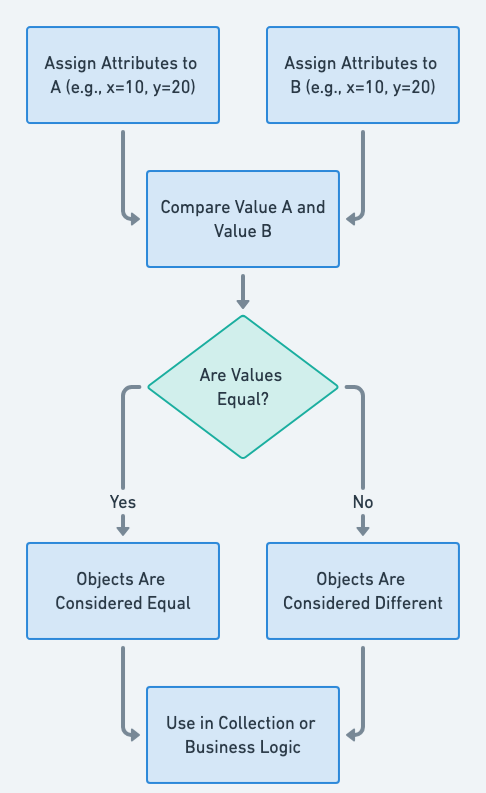Value Object Pattern in Java: Enhancing Performance with Immutable Data Types
Also known as
- Embedded Value
- Immutable Object
- Inline Value
- Integrated Value
Intent of Value Object Design Pattern
The Value Object pattern in Java creates immutable objects that represent a descriptive aspect of the domain with no conceptual identity. It aims to enhance performance and reduce memory overhead by storing frequently accessed immutable data directly within the object that uses it, rather than separately.
Detailed Explanation of Value Object Pattern with Real-World Examples
Real-world example
Consider the case of a business card. In our example, a BusinessCard class is implemented as a Value Object to demonstrate immutable data handling and efficiency in Java applications. In the real world, a business card contains information such as the person's name, job title, phone number, and email address. This information represents a specific and complete set of attributes describing the contact details of an individual but doesn't have an identity itself beyond this information.
In a software system, you can create a
BusinessCardclass as a Value Object. This class would be immutable, meaning once aBusinessCardobject is created with a person's details, those details cannot change. If you need a different business card, you create a new instance rather than modifying the existing one. The equality of twoBusinessCardobjects would be based on their contained data rather than their memory addresses, ensuring that two business cards with the same details are considered equal. This mirrors how business cards in real life are used and compared based on their content, not on the physical card itself.
In plain words
Value objects are equal when their attributes have the same value.
Wikipedia says
In computer science, a value object is a small object that represents a simple entity whose equality is not based on identity: i.e. two value objects are equal when they have the same value, not necessarily being the same object.
Flowchart

Programmatic Example of Value Object Pattern in Java
There is a class for hero statistics in a role-playing game. The statistics contain attributes such as strength, intelligence, and luck. The statistics of different heroes should be equal when all the attributes are equal.
Here is the HeroStat class that is the value object. Notice the use of Lombok's @Value annotation.
@Value(staticConstructor = "valueOf")
@ToString
class HeroStat {
int strength;
int intelligence;
int luck;
}The example creates three different HeroStats and compares their equality.
public static void main(String[] args) {
var statA = HeroStat.valueOf(10, 5, 0);
var statB = HeroStat.valueOf(10, 5, 0);
var statC = HeroStat.valueOf(5, 1, 8);
LOGGER.info("statA: {}", statA);
LOGGER.info("statB: {}", statB);
LOGGER.info("statC: {}", statC);
LOGGER.info("Are statA and statB equal? {}", statA.equals(statB));
LOGGER.info("Are statA and statC equal? {}", statA.equals(statC));
}Here's the console output.
20:11:12.199 [main] INFO com.iluwatar.value.object.App - HeroStat(strength=10, intelligence=5, luck=0)
20:11:12.202 [main] INFO com.iluwatar.value.object.App - HeroStat(strength=10, intelligence=5, luck=0)
20:11:12.202 [main] INFO com.iluwatar.value.object.App - HeroStat(strength=5, intelligence=1, luck=8)
20:11:12.202 [main] INFO com.iluwatar.value.object.App - Is statA and statB equal : true
20:11:12.203 [main] INFO com.iluwatar.value.object.App - Is statA and statC equal : falseWhen to Use the Value Object Pattern in Java
Use the Value Object when
- Apply the Value Object pattern when you need high-performance Java applications with reduced memory overhead, especially in systems requiring efficient data management.
- When representing a set of attributes that together describe an entity but without an identity.
- When the equality of the objects is based on the value of the properties, not the identity.
- When you need to ensure that objects cannot be altered once created.
- An application requires high performance and the data involved is immutable.
- Memory footprint reduction is critical, especially in environments with limited resources.
- Objects frequently access a particular piece of immutable data.
Value Object Pattern Java Tutorials
Real-World Applications of Value Object Pattern in Java
- Implementing complex data types like monetary values, measurements, and other domain-specific values.
- java.util.Optional
- java.time.LocalDate
- java.awt.Color
- joda-time, money, beans
Benefits and Trade-offs of Value Object Pattern
Benefits:
- Simplifies code by making objects immutable.
- Thread-safe as the object's state cannot change after creation.
- Easier to reason about and maintain.
- Reduces the memory overhead by avoiding separate allocations for immutable data.
- Improves performance by minimizing memory accesses and reducing cache misses.
Trade-offs:
- Creating a new object for every change can be less efficient for complex objects.
- Increased memory usage due to the creation of multiple objects representing different states.
- Increases complexity in object design and can lead to tightly coupled systems.
- Modifying the embedded value necessitates changes across all objects that embed this value, which can complicate maintenance.
Related Java Design Patterns
- Factory Method: Often used to create instances of value objects.
- Flyweight: Shares objects to support large quantities using a minimal amount of memory, somewhat similar in intent but different in implementation.
- Builder: Can be used to construct complex value objects step by step.
- Prototype: Can be used to clone existing value objects, though cloning is less common with immutable objects.
- Singleton: Ensures a class has only one instance and provides a global point of access to it, can be used to manage a shared embedded value.